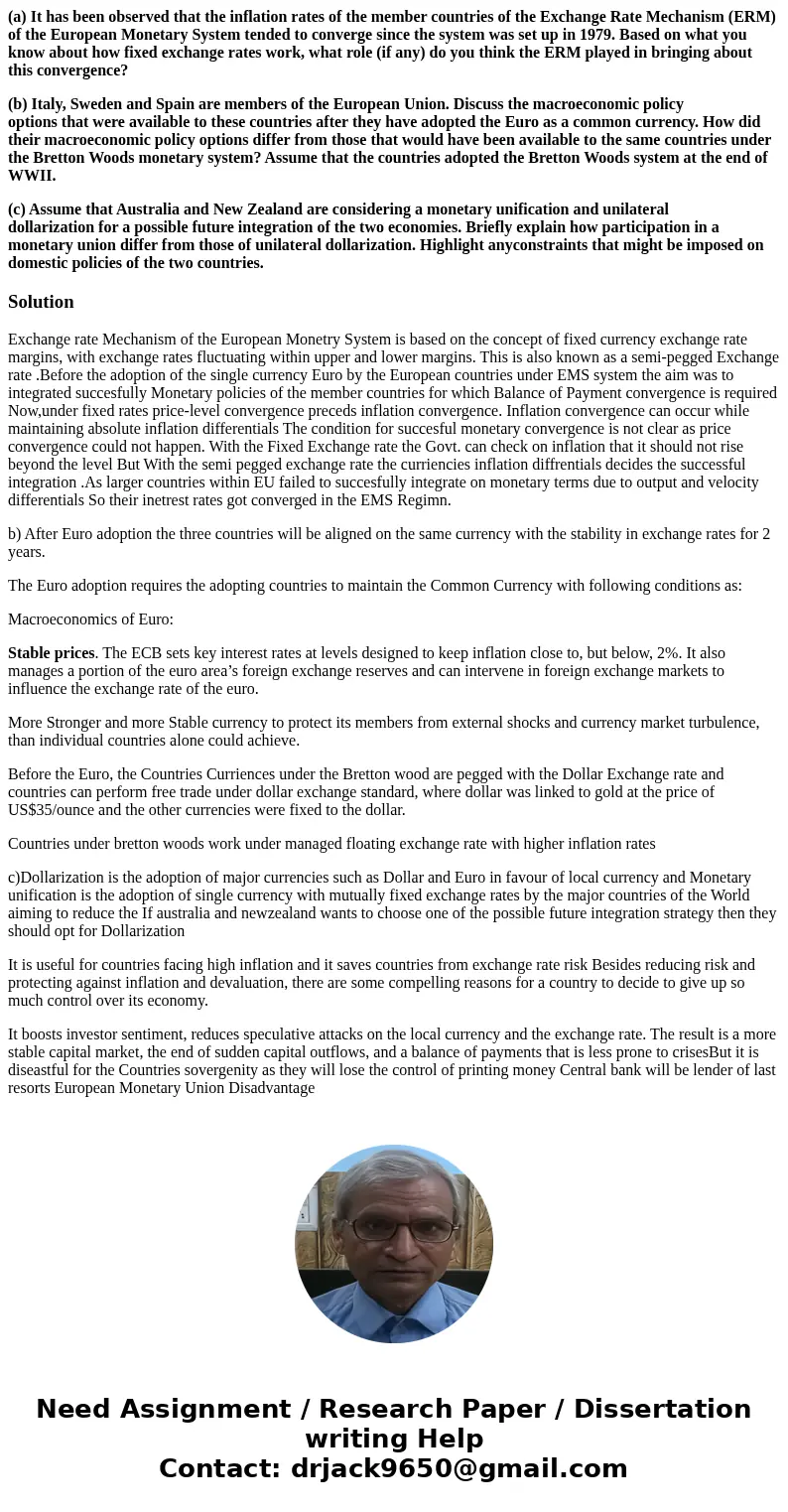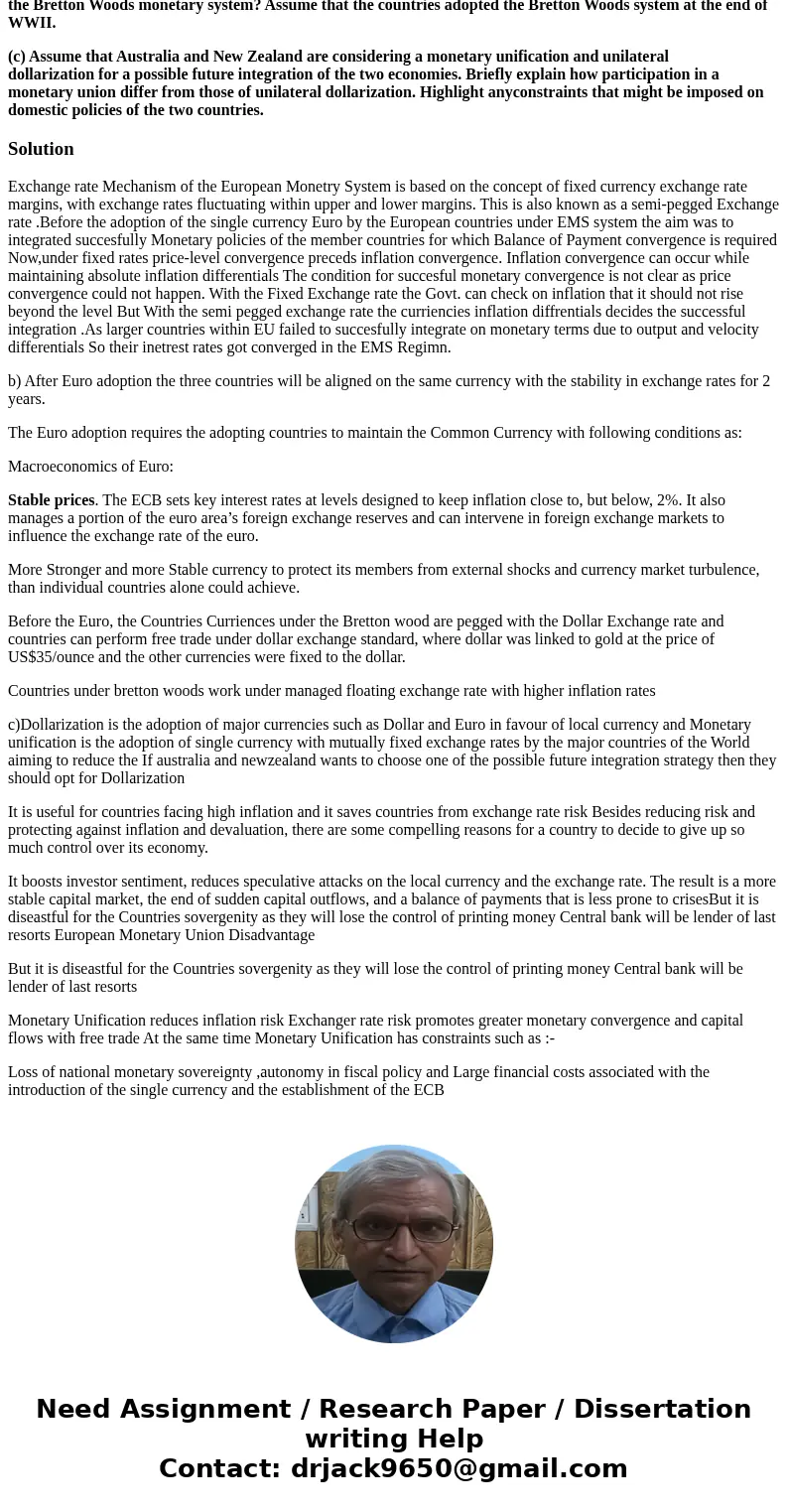a It has been observed that the inflation rates of the membe
(a) It has been observed that the inflation rates of the member countries of the Exchange Rate Mechanism (ERM) of the European Monetary System tended to converge since the system was set up in 1979. Based on what you know about how fixed exchange rates work, what role (if any) do you think the ERM played in bringing about this convergence?
(b) Italy, Sweden and Spain are members of the European Union. Discuss the macroeconomic policy options that were available to these countries after they have adopted the Euro as a common currency. How did their macroeconomic policy options differ from those that would have been available to the same countries under the Bretton Woods monetary system? Assume that the countries adopted the Bretton Woods system at the end of WWII.
(c) Assume that Australia and New Zealand are considering a monetary unification and unilateral dollarization for a possible future integration of the two economies. Briefly explain how participation in a monetary union differ from those of unilateral dollarization. Highlight anyconstraints that might be imposed on domestic policies of the two countries.
Solution
Exchange rate Mechanism of the European Monetry System is based on the concept of fixed currency exchange rate margins, with exchange rates fluctuating within upper and lower margins. This is also known as a semi-pegged Exchange rate .Before the adoption of the single currency Euro by the European countries under EMS system the aim was to integrated succesfully Monetary policies of the member countries for which Balance of Payment convergence is required Now,under fixed rates price-level convergence preceds inflation convergence. Inflation convergence can occur while maintaining absolute inflation differentials The condition for succesful monetary convergence is not clear as price convergence could not happen. With the Fixed Exchange rate the Govt. can check on inflation that it should not rise beyond the level But With the semi pegged exchange rate the curriencies inflation diffrentials decides the successful integration .As larger countries within EU failed to succesfully integrate on monetary terms due to output and velocity differentials So their inetrest rates got converged in the EMS Regimn.
b) After Euro adoption the three countries will be aligned on the same currency with the stability in exchange rates for 2 years.
The Euro adoption requires the adopting countries to maintain the Common Currency with following conditions as:
Macroeconomics of Euro:
Stable prices. The ECB sets key interest rates at levels designed to keep inflation close to, but below, 2%. It also manages a portion of the euro area’s foreign exchange reserves and can intervene in foreign exchange markets to influence the exchange rate of the euro.
More Stronger and more Stable currency to protect its members from external shocks and currency market turbulence, than individual countries alone could achieve.
Before the Euro, the Countries Curriences under the Bretton wood are pegged with the Dollar Exchange rate and countries can perform free trade under dollar exchange standard, where dollar was linked to gold at the price of US$35/ounce and the other currencies were fixed to the dollar.
Countries under bretton woods work under managed floating exchange rate with higher inflation rates
c)Dollarization is the adoption of major currencies such as Dollar and Euro in favour of local currency and Monetary unification is the adoption of single currency with mutually fixed exchange rates by the major countries of the World aiming to reduce the If australia and newzealand wants to choose one of the possible future integration strategy then they should opt for Dollarization
It is useful for countries facing high inflation and it saves countries from exchange rate risk Besides reducing risk and protecting against inflation and devaluation, there are some compelling reasons for a country to decide to give up so much control over its economy.
It boosts investor sentiment, reduces speculative attacks on the local currency and the exchange rate. The result is a more stable capital market, the end of sudden capital outflows, and a balance of payments that is less prone to crisesBut it is diseastful for the Countries sovergenity as they will lose the control of printing money Central bank will be lender of last resorts European Monetary Union Disadvantage
But it is diseastful for the Countries sovergenity as they will lose the control of printing money Central bank will be lender of last resorts
Monetary Unification reduces inflation risk Exchanger rate risk promotes greater monetary convergence and capital flows with free trade At the same time Monetary Unification has constraints such as :-
Loss of national monetary sovereignty ,autonomy in fiscal policy and Large financial costs associated with the introduction of the single currency and the establishment of the ECB


 Homework Sourse
Homework Sourse